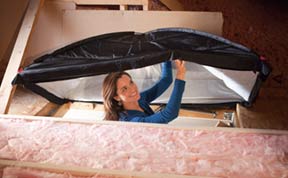Weatherizing Your Home Can Mean Big Benefits

"The U.S. Department of Energy suggests homeowners spend nearly 50 percent of their utility bills on space heating and cooling, with heating accounting for the largest portion of money spent," said Stephen Wagner, assistant category manager at ShurTech Brands, LLC, the marketers of the Duck brand. "With so much spent, it's important to take measures to save energy and money. Something as simple as weatherizing can help block air leaks and drafts, helping to keep energy bills low."
The good news is that if you haven't already weatherized, it's not too late. The following tips will help prepare your home for not only freezing temperatures but also the warmer summer months:
* Start with the attic. The top of the house tends to be forgotten as a source of energy loss. To combat this, Duck brand Attic Stairway Covers can help seal attic stairway openings by helping to block drafts, saving energy all year round. These pop-up covers are flexible and lightweight, easily repositionable to allow attic access and simple to assemble and install.
* Check the windows. As houses age, window casings loosen and become drafty. To add a barrier between your home and the elements, consider the Roll-On Window Kit from the same brand. The crystal-clear shrink film requires no measuring and provides an airtight seal over interior window frames, creating an insulating air space between the film and window glass.
* Make sure doors are properly sealed. Not only does weatherizing the bottom of doors help prevent drafts, it also protects from dust, insects and pollen during warmer months. Duck brand Double Draft Seal is designed to work on a variety of floor types and has a patented design that offers two layers of protection from drafts -- straps hold the seal in place while it "hugs" the bottom of the door from inside and outside.
* Consider the walls. You might not know this, but energy loss can also come from sources such as electrical outlets and switch plates on exterior walls. Socket Sealers prevent drafts by acting as a buffer between the outside temperatures and your home's interior.
* Fill cracks and gaps. For stationary components, caulk is the appropriate material for filling cracks and gaps. Around windows and doors, weatherstripping, such as Duck brand window and door weatherstrip seals, provides a barrier against the elements, helping to insulate your home. For those who live in extreme temperatures, try a Heavy-Duty Weatherstrip seal made with EPDM rubber.
For more information, visit www.duckbrand.com.

No comments: